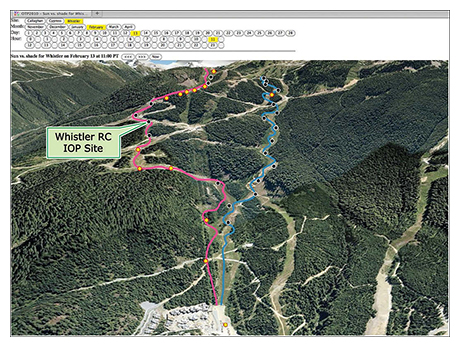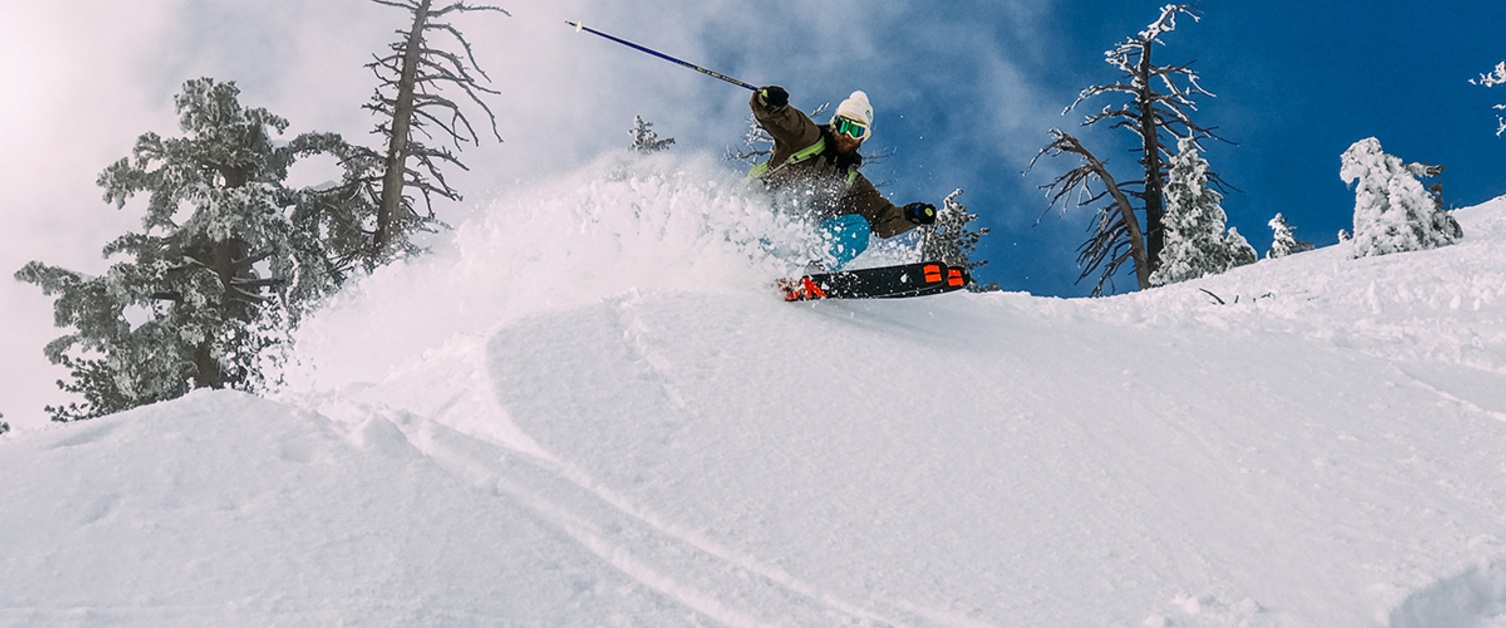Sun or Shade? How Forecasting Changed Ski Racing at the 2010 Winter Olympics
- By Rosie Howard and Roland Stull
- Jan 13, 2021
The sun’s rays can affect the surface of a snowpack within seconds: increasing the temperature, modifying the liquid water content within the first few centimeters of depth, and changing the structure of the snowpack, especially in terms of grain size, bonding between grains, and hardness of snowpack. A fair amount of research has focused on how shadows and sunlight in complex terrain contribute to avalanche danger. However, sunlight and shadowing also alter the groomed snow surfaces used for ski racing. The impacts of sun and shade can be seen on everything from the way the course is prepared and how the cameras are positioned for television broadcasting all the way down to the ski chosen for the race and the type of wax placed on that ski.
Ski-snow friction depends upon many processes, including dry friction, wet (lubricated) friction, snow compaction, impact resistance, capillary adhesion, electrical charging, abrasion, and contamination with dirt particles. Meteorological variables that indirectly affect friction are humidity, air temperature, snow temperature, and solar radiation. Friction between snow and skis is also somewhat dependent on the prevailing snow crystal type, the temperature, and liquid water content of the snow, all of which are influenced by solar radiation.
Sun and Shade Effects
Solar radiation can significantly affect the results of ski races because of its effect on snow temperature. Snow temperature is impacted by solar and infrared (IR) radiation and in turn, snow temperature changes the amount of friction between skis and snow. Solar radiation heats the ski base directly and uniformly, but some of the photons that enter the snowpack are scattered back out as infrared radiation. Most of this radiation from a ski piste (a compacted and groomed ski trail) is usually upward toward space (day and night, sunny and shady). When this occurs, especially in cloudless conditions, it creates an unrelenting cooling process.
It is important to underscore the strength of the impact that sunlight can have on the race course. In studies such as Colman (1994), ski runs made well after sunset showed that even small amounts of diffuse sunlight on a cloudy day provided a reduced but significant source of energy to affect skis. Not only should the amount of solar radiation be considered when choosing ski wax and structure, but also when choosing the color of a ski base. At low speeds, the heat produced by solar radiation on a black ski base could actually be more than the heat produced by friction.
And what about shade? Testing under controlled conditions has shown that the heat balance at the snow surface can cause as much as a 4°C difference between sunny and shady conditions. It is therefore not surprising that athletes have to prepare and wax their skis much differently for shaded snow than for snow receiving direct or strong diffuse solar radiation. So, knowledge ahead of time of when and where the sun will hit the race course can be vital for achieving a clean run. For example, on the morning of a ski race, testing may take place on shaded snow; however, the sun might shine fully or partially onto the piste later in the day when the race gets underway.
Changing the Course of the 2010 Olympic Games
The Winter Olympics, taking place every four years, offer one of the preeminent ski racing competitions in the world. In 2010, the Olympic venues were located in southwest coastal British Columbia (BC), Canada.  Recognizing the critical role that meteorological conditions would play in the competition, researchers worked with the Vancouver Olympic Committee to create a cost-effective sun/shade prediction method to help ski technicians, coaches, and athletes be better prepared for race conditions.
Recognizing the critical role that meteorological conditions would play in the competition, researchers worked with the Vancouver Olympic Committee to create a cost-effective sun/shade prediction method to help ski technicians, coaches, and athletes be better prepared for race conditions.
Previous methods for calculating solar radiation and effects on mountainous terrain included using digital elevation models, similar to work in numerical weather prediction and hydrology. These methods can be computationally expensive and relatively complex, and they usually include only the effects of the topography, as described in digital elevation models. However, for the outdoor Olympics venues, the race pistes were bordered by tall (order of 20 m) evergreen trees that also caused significant shading. To get around costly computing power and still quickly determine whether a point on the Earth’s surface was in the sun or shade on a cloudless day, the project used field surveys to collect data and calculate the following: local elevation and azimuth angles of the sun, and elevation and azimuth angles of the visible horizon, defined by shadow-casting obstacles, such as mountains, trees, and structures.
Creating a Field Survey-Based Methodology
A theodolite (Pentax, GT-4B) was used to make these local horizon surveys at a series of points along each Olympic ski and snowboard race course at Callaghan, Cypress, and Whistler. Points were chosen with some guidance from race staff, at an approximate interval of 150 m. Although this interval was not small enough to provide complete coverage, it was sufficient to provide representative information to ski technicians, coaches, and other race officials. Thirty-five points were surveyed at Whistler, 60 at Callaghan, and 38 at Cypress. At each point, the theodolite was erected and leveled with built-in bubble levels, and the zero-azimuth set to magnetic north using the built-in compass. The latitude and longitude of each point was noted using a GPS unit. Local horizon elevation angles were measured for every 5° azimuth, where the horizon elevation angle is the angle above horizontal at which the top of any local or nonlocal object (tree, mountain, etc.) was observed. Only the sky is higher than this point. Azimuth angles were later converted to a true north coordinate system by adding the local magnetic variation angle of 17.9°E (NRC 2010). The local horizon data were input into a program that calculates the geometry of the sun and Earth for every half-hour, for any dates chosen. Horizon elevation angles were compared with the sun elevation angles for each azimuth and time of day. As a result of the survey and calculations, each location could then be assigned a flag that indicated either sun or shade as the sun moved throughout the day.
Data Collection and Implementation
The three outdoor venues for which sun/shadow calculations were made were as follows:
- Callaghan Valley, Whistler Olympic Park: Nordic skiing venue
- Whistler Mountain: Alpine skiing venue
- Cypress: Freestyle skiing venue
Sun angles and the sun-versus-shade flag were calculated in advance for the 133 survey points. Output was calculated in half-hourly intervals for every day from November 2009 to April 2010. These dates were chosen to include the Olympic and Paralympic Winter Games (12–28 February 2010 and 13–21 March 2010, respectively) as well as prior training and testing dates. Output was an array for each survey-point location giving the day of year, time (UTC), sun elevation angle (degrees), net solar radiation at the top of the atmosphere (W m−2), and shade/no-shade flag (binary: shade = 0, sun = 1). Results were provided to the Canadian Olympic and Paralympic teams and the Vancouver Olympic Committee (VANOC).
The Olympic Impact
In order to make this available to ski racers and coaches, researchers designed a graphical user interface (GUI) to display the sun-versus-shade data via the Internet. They chose high resolution aerial photographs of each venue that had the fewest shadows possible to use as background images. These images were mapped onto digital elevation data to present a 3D view of the scene to the user. The actual race lines were then drawn on these background images for context. 
This image shows a snapshot of the finished display for Whistler Mountain. The user can see predictions of the sun on pistes at specified locations, given the month, day, and time chosen by the user. Predictions were valid only for clear sky conditions or for days when bright diffuse sunlight is present [e.g., thin cloud layer(s)]. The GUI allowed the user to select the venue (Callaghan/Cypress/Whistler), month, day, and time to see the shading on a race course.
Ski technicians, coaches, and other race officials accessed the website on a daily basis prior to and during the Olympics. Course preparation and sports managers were also interested, particularly given the occurrence of moderate-to-strong El Niño conditions (NOAA 2010) with an intense Aleutian low and associated southerly winds bringing warm air northward along the North American west coast (Crawford 2010). There were at least six consecutive mostly sunny days during the Olympics (17–22 February 2010) and four days during the Paralympics (17–20 March 2010) that could possibly be attributed to this El Niño event. Regardless, all the mostly sunny days had race events at all the Olympic venues for which the sun-versus-shade information was used and found valuable.
This experience during the 2010 Olympics also resulted in the following recommendations for future use of sun/shade prediction for ski races:
-
The azimuthal and spatial resolution of theodolite measurements should be increased to allow for higher time resolution and to “fill in” gaps along the race courses. Sufficient time must be allowed to conduct the theodolite surveys, which take about two hours per site, including theodolite setup, calibration, observing and recording the horizon data, packing up, and hiking to the next location.
-
For greater model accuracy, a correction could be made to include the radius of the sun rather than assuming it is infinitesimal, as well accounting for the height of the theodolite axes from the ground/ snow surface.
-
Further research could be applied to combine the sun-versus-shade output with numerical weather prediction output to determine, for example, the maximum temperatures or temperature change expected based upon the maximum direct solar radiation.
And What About Snowboards?
The behavior of snowboards in sun and shade was observed informally during competitions and training leading up to the 2010 Vancouver Winter Olympic and Paralympic Games (“Olympics”). When the snow surface was initially warm and soft with large granules and then the same snow surface transitioned into the shade, it became “like sandpaper” and could be abrasive after several snowboard runs. For these conditions it was necessary to change the type of wax, and more work was required to rewax the snowboards between each run. Both of these factors can have a large impact on the outcome of competitions. From these observations, it became clear that the condition of the snow surface, in particular whether it is in direct sun or shaded, is of interest for all types of races, including both skiers and snowboarders.
This article has been specially edited for the AMS Weather Band. Any omissions or errors of syntax or grammar may be attributed to AMS Staff.
